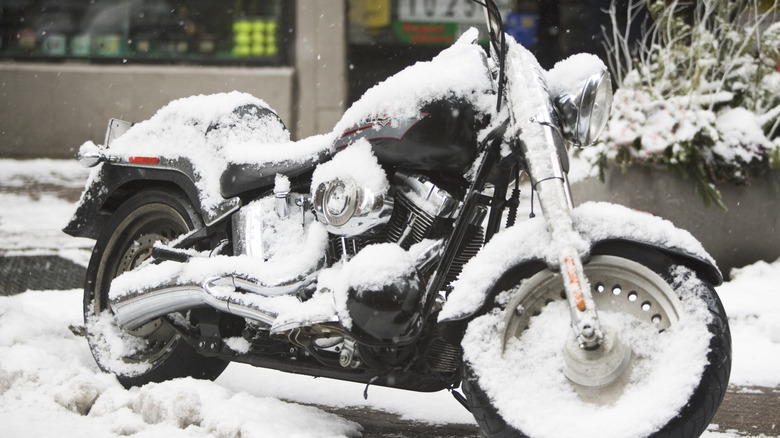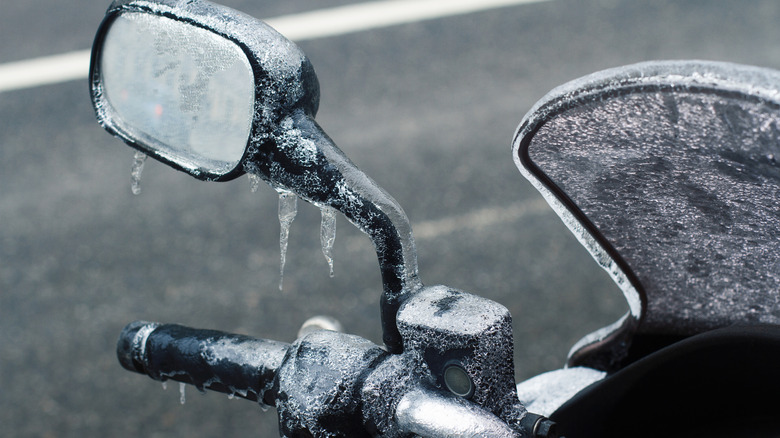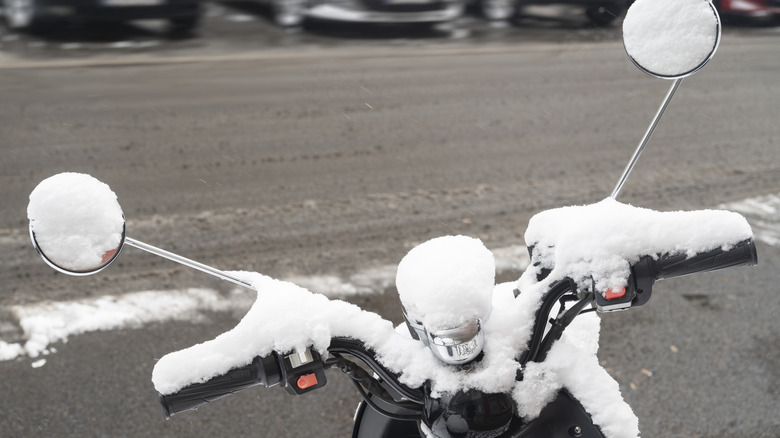How Much Fuel Stabilizer Does Your Motorcycle Need For Winter?
We may receive a commission on purchases made from links.
Owning and riding a motorcycle can be quite a thrilling hobby, however, it's not all fun and games. This proves especially true in the winter months, as colder weather calls for the implementation of proper motorcycle storage tips and preparation for said hibernation, known as winterizing. One of the most crucial steps one should take is adding fuel stabilizer to your motorcycle's fuel tank. This additive prevents fuel from breaking down and gelling in the fuel lines, allowing gas to flow freely and for your bike to start up on a dime once you get it out for the riding season. It's key to know exactly how much to use, which varies from brand to brand.
For example, if you're looking into the STA-BIL brand stabilizer, a 4-ounce bottle is good for 10 gallons of fuel, 8 ounces for 20 gallons, and 32 ounces for 40 gallons. Amsoil stabilizer is at the same measurement, recommending 1 ounce per 2.5 gallons of fuel. Meanwhile, the recommended ratio for Yamaha fuel stabilizer is 1 ounce per 3 gallons of fresh fuel for extended storage. This ratio changes to 1 ounce per 1 gallon if storage is only for a couple of months. As for Liqui Moly, around .85 ounces is good for just over 1.3 gallons. Once you know how much stabilizer to add, pour it in, start the engine up for a bit to distribute it throughout the bike, and you're good to go.
Evidently, adding fuel stabilizer in your motorcycle for the winter isn't as simple as just pouring some into your tank without a thought. If you're not mindful of the correct amount to add, you run the risk of it not doing its job.
The importance of adding the right amount of fuel stabilizer
The process of winterizing a motorcycle before cold storage in general isn't too extensive, but each step is important to do right. When it comes to using fuel stabilizer in your motorcycle effectively, a bit of measuring is involved. You have to determine just how much total gasoline is in the tank already, then move on to the correct amount to pour in based on the brand's recommended measurements. You can typically find how much you can put in per the amount of gas in the tank by checking the label on the container, since it can tend to vary a bit from brand to brand.
If you're not conscious of these measurements, the stabilizer you pour in could prove a non-factor at best and an active danger to your motorcycle at worst. Its a good idea to add stabilizer on a full fuel tank, eliminating any remaining air space within. If you fail to do so, this could lead to some interior parts being unaffected by the added stabilizer. This could lead to a build up of condensation, which could cause rust, causing big headaches at the start of the riding season.
Which fuel stabilizer brands are most recommended?
With so many fuel stabilizer choices to go with, it can be tough deciding which is the best one for you. Fortunately, riders from all over have shared their recommendations online, providing guidance to those new to the motorcycle winterization process. The previously mentioned STA-BIL has received plenty of positive assessments online. "I have used StaBil for years and trust it. Never have had any issues with gas. Even have had gas stay OK for up to 2 years," commented hardrocko in their Amazon review of the stabilizer. Others feel it greatly improved the quality of the fuel it was mixed with, helping machines run even better than before.
The Lucas Oil brand stabilizer has won over many customers as well, with George on Amazon noting that it even seemed to clean their motorcycle's fuel injectors to boot. "By far the BEST fuel treatment available. This was recommended by my original bike mechanic, Use it in my Harley and the grandkids dirt bike and 4 wheeler. Really helps keep your carb working the way it should," Amazon user Bob Matthews said of their experience with Star Brite stabilizer, while Chad S. used it to recuperate an ethanol fuel-damaged — because ethanol can be bad for some engines — 20-year-old Harley-Davidson.
Of course, it should be said that one's individual results may vary. These are merely some examples of how well these products can work when used right. When the weather gets colder, don't forget to winterize. Adding the right amount of fuel stabilizer to your motorcycle over the colder months will keep it in good shape for longer, and ensure it's ready to hit the road come spring.


